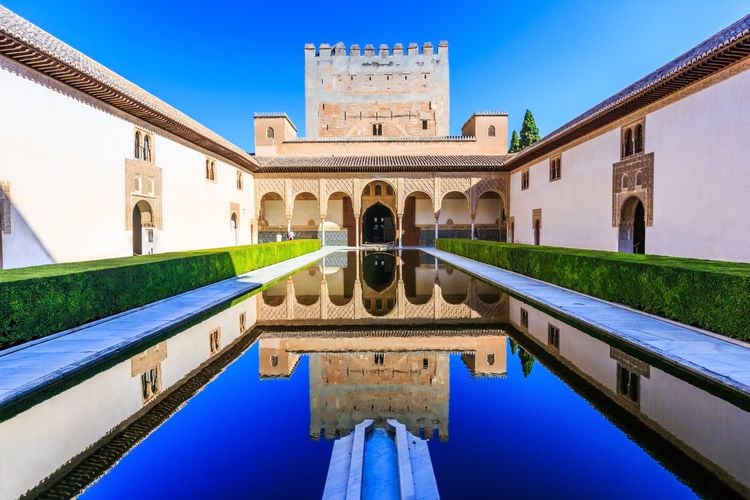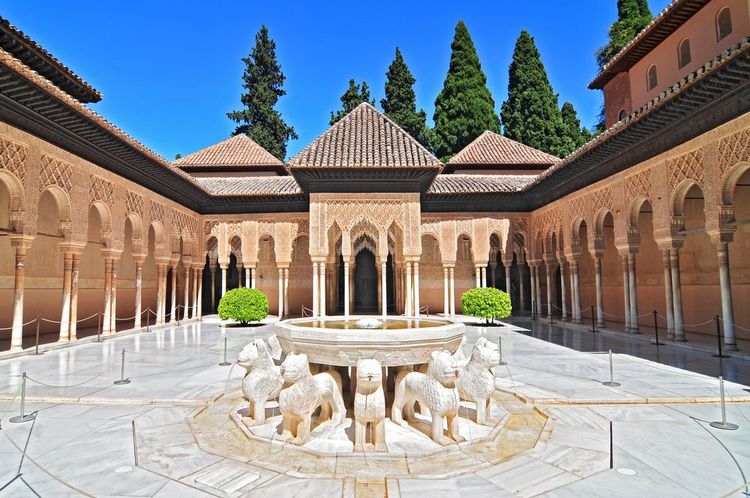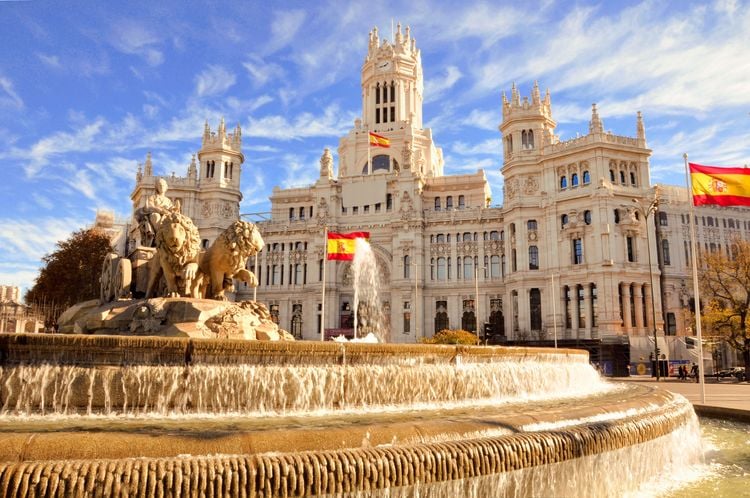The Alhambra in Granada is not one of the New Seven Wonders of the World. We wonder why, because this site has no equivalent on the planet. Classified by UNESCO in 1984, this city within a city, both palace and garden, is one of the places you must see at least once in your life.
A tour of Andalusia, Spain's southernmost province, takes you back to the splendours of the Muslim era: palaces, gardens and mosques transformed into churches or cathedrals mingle with the riches brought back from America in the wonders of Cordoba, Granada and Seville. White villages and Moorish castles clinging to the Sierra Nevada, the deserts and beaches of the Costa Del Sol are combined with flamenco, bullfights, ferias and tapas in the bright sunshine. Viva Espana!
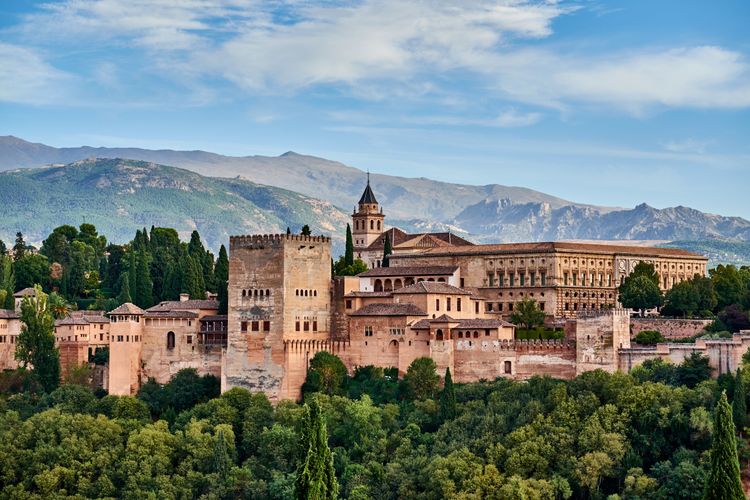
Le fabuleux site de l’Alhambra, à Grenade
- © Macronatura.es / ShutterstockDay 1: Granada's Alhambra, an Andalusian jewel
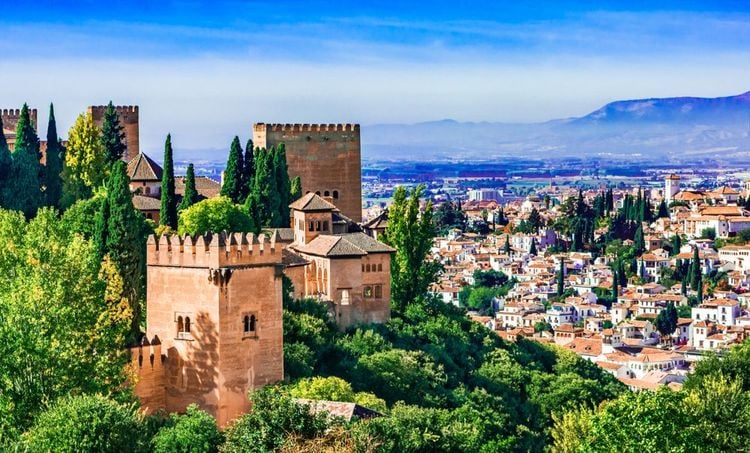
Panoramic view of the Alhambra
- © David Ionut / ShutterstockRome, Lisbon, Istanbul, many cities have passed the word on to build themselves on seven hills! Granada is one of them, and the Alhambra is one of these seven hills, a city within a city, like the Forbidden City in Beijing or the Kremlin in Moscow. Here, it is fortified and protected by a 2km double wall with four gates at the four cardinal points, embellished by 30 towers. Fallen after a 10-month siege in 1492, the last Muslim kingdom in Europe was spared by the Catholic kings, who preserved this marvel from destruction.
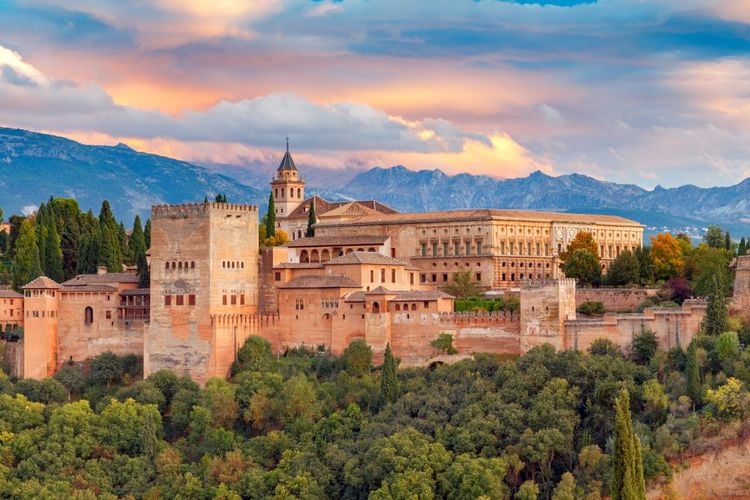
L’Alhambra, carte postale de l’Andalousie, se niche dans un cadre majestueux avec en toile de fond les neiges éternelles de la Sierra Nevada
- © kavalenkau / ShutterstockSpain's most visited site, with 3 million visitors a year, the Alhambra receives 8,000 visitors a day all year round, and can take no more. The crowds are there all year round, so there will be the same number of tourists in July as in November! Don't panic though, the site is so big - between the Nasrid palace, Charles V's palace, the Alcazaba (military fortress) and the Generalife's gardens, the Alhambra covers 2,000 hectares! You'll find peace and quiet in some places, but less so in others, such as the emblematic Lion's Courtyard, the Throne Room and the Patio of the Myrtles. That said, a room can be empty and then fill up with a flood of visitors in the space of five minutes!
In the evening, don't miss the view of the Alhambra and Sierra Nevada from the San Nicolas viewpoint! The city becomes magical at sunset, when the fortifications of the Alhambra colour it in ochre and red.
Where to sleep?
⭐ Parador de Grenada
It couldn't be better located: set in the heart of the Alhambra, between the Nasrid palace and the Generalife gardens, the Parador occupies the heights of Granada, on a hill overlooking the old Muslim quarter of the Albaicín. This magical site is housed in a thirteenth-century convent of unrivalled charm. Facilities are limited and there is no swimming pool or spa, but that's not why you come here! The icing on the cake is the delicious Muslim-inspired cuisine!
 Grenada
Grenada
Parador de Granada
4* hotel located within the Alhambra in GranadaDay 2: Granada and Cordoba
Granada Cathedral
From the Alhambra, it's a pleasant 15-minute walk to the city centre and its cathedral. The narrow streets of the historic centre and the Albaicin quarter are particularly charming. The cathedral's Royal Chapel sums up the grandeur of this Renaissance-style building. Its stained glass dome is of great beauty and features sculptures and paintings by Alonso Cano.

L’intérieur de la cathédrale de Grenade est splendide
- © Farbregas Hareluya / ShutterstockVisiting the cathedral left you hungry? Then head for Calle de Las Naves, 500 metres from the cathedral, considered to be the tapas street: a meeting place for the locals! In every bar, at lunchtime or dinnertime, if you order a drink, you'll be offered one (the price of the drink includes the tapa). This feature will also tell you whether you're in a typical bar or a touristy one - only touristy establishments charge for these appetisers... It's time to head for the beautiful city of Cordoba, a 2-hour drive away.
Cordoba and its mosque-cathedral
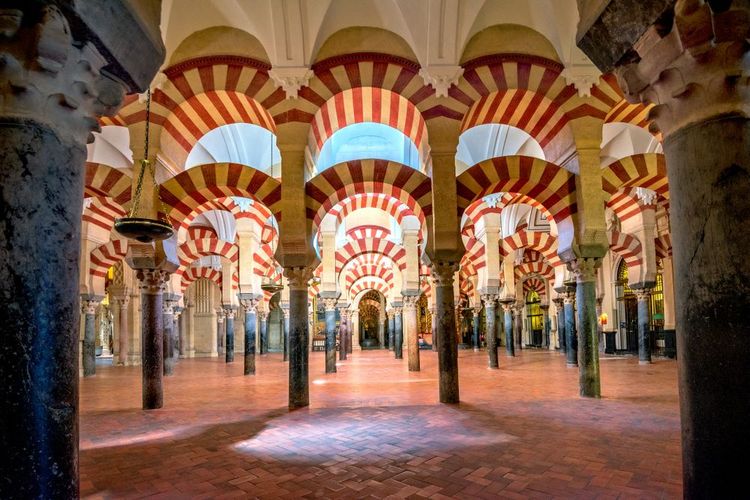
La mosquée cathédrale à Cordoue de 24 000 m² mêlant les styles omeyyade, gothique, renaissance et baroque impressionne dès l'extérieur, avec son clocher qui n'est autre que l'ancien minaret
- © Valery Bareta / ShutterstockIdeally situated halfway between Seville and Granada, Cordoba is an essential stop-off point on any tour of Andalusia. Curled up on the banks of the Guadalquivir, the former capital of the Caliphate of Cordoba is less well known than its Andalusian rivals, but can be explored in a day. The highlight of the visit is the mezquita, a former mosque turned cathedral. An emblematic monument for a city where the Roman, Muslim and Jewish heritages are omnipresent.
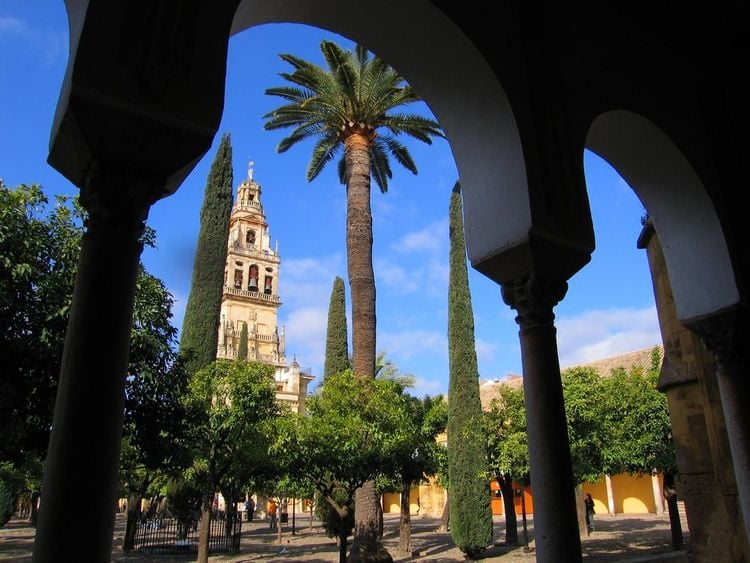
Cour de la Mezquita
- © @cam / ShutterstockPractical info
Alhambra of Granada
📆 Open: 1 April to 14 October daily and Tuesday to Saturday for night visits. From 15 October to 31 March, daily and on Fridays and Saturdays for night visits.
⏰ Opening times: 8.30am to 8pm and 9pm to 11.30pm from April to October. From 8.30am to 6pm and from 7pm to 9.30pm from October to March.
👛 Price:
- 11 euros for adults
- 10 euros for pensioners and students aged 15 to 26
- 7 euros for children aged 10 to 14
- Free for children under 10
Add €3 to climb the bell tower. For evening visits, the general rate is 20 euros, reduced rate 14 euros and free for children under 7.
🎟️ You can book your tickets here
Mosque-Cathedral Cordoba
⏰ Opening times: daily from 10am to 7pm. Night visits are available at 9.30pm and 11pm.
👛 Price:
- 19.09 euros for adults
- 12.73 euros for young people aged 12 to 15
- Free for children under 11
🎟️ You can book your tickets here
👉 Good to know: from Monday to Saturday, from 8.30am to 9.30am, the visit is free!
Where to sleep?
⭐ Las Casas de la Judería de Córdoba
Las Casas de la Judería comprises five houses, the oldest of which dates from the late 15th century, in the heart of the Judería district, a two-minute walk from the Alcázar and around ten minutes from the Cathedral-Mosque. The food is excellent and the welcome top-notch. It's hard not to fall under the spell of this traditional Andalusian house!
 Cordoba
Cordoba
Las Casas de la Judería de Córdoba
Boasting an outdoor swimming pool and bar, the charming Las Casas de la Judería de Córdoba is 250 metres from the Cathedral Mosque of Córdoba.Day 3: Off to Ronda
Before leaving for Ronda, there are still a few must-sees in Córdoba, including the gardens of the Alcazar de los Reyes Cristianos and the Roman bridge over the River Guadalquivir.
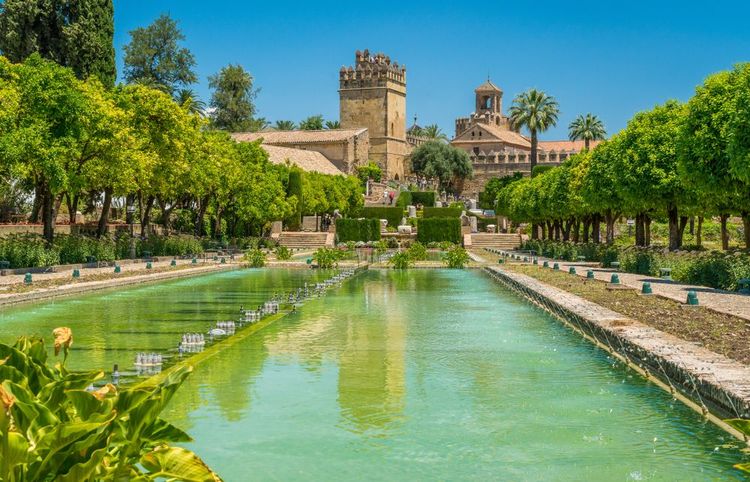
Le magnifique Alcazar de los Reyes Cristianos
- © essevu / ShutterstockOn the banks of the Guadalquivir, the Alcazar of the Christian Kings, the fortified residence of the Caliphs and then the Catholic kings, is a marvel! Our favourite part? A stroll through its magnificent, harmonious gardens, punctuated by the pleasant flow of water from the fountains and the song of the birds. It was in these gardens that Christopher Columbus met the Christian Monarchs in 1492, in preparation for his expedition to discover America that same year!

Le pont romain et la mosquée (cathédrale) sur le Guadalquivir
- © SCStock / ShutterstockAlso known as the Old Bridge (built in 45 BC, after all!), Cordoba's Roman bridge spans the Guadalquivir river and links the Campo de la Verdad and Cathedral districts. It is one of the filming locations for the famous Game of Thrones series. A Roman heritage that resurfaces every time the city is excavated. Ruins can be found here in hotels and public places, much like in Rome.
👉 Anecdote: The words cobbler and shoemaker come from the city of Cordoba, whose leather was highly prized in the Middle Ages.
Ronda
It's a two-hour drive to one of Spain's oldest towns. Built on a rocky promontory, Ronda is split in two by a deep ravine, which is crossed by the Puente Nuevo, a not-so-new bridge dating back to the 18th century, suspended 100 metres above sea level! Also worth seeing: the Palacio de Mondragon, a remarkable Arab-style residence with a small museum, and the Plaza de Toros, Spain's first bullring, inaugurated in 1785. It was in Ronda that Pedro Romero laid down the rules for bullfighting.
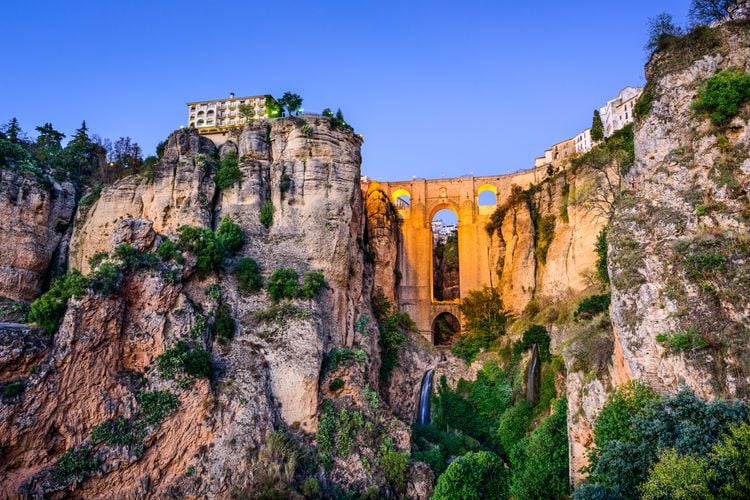
Pont Puente Nuevo au crépuscule
- © Sean Pavone / ShutterstockAdvice from the editor
For the best views of the bridge, head up the narrow streets of the town centre and enjoy a drink on the hidden terraces of the restaurants overlooking the ravine!
Ronda is best visited early in the morning and in the evening, when the hordes of tourists have not yet arrived or left!
If you're afraid of heights, be careful not to lean over the Roman bridge, as the void is impressive and you could fall! Similarly, if you venture onto the path that runs alongside the canyon, be careful not to slip.
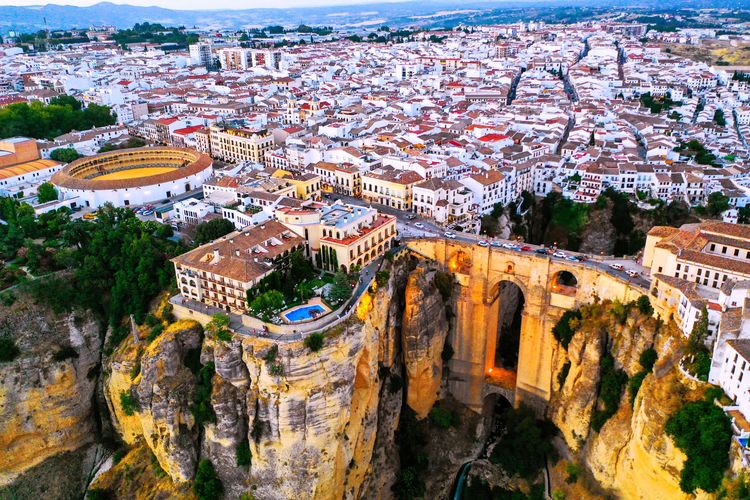
Aerial view of Ronda
- © Madrugada Verde / ShutterstockWhere to sleep?
⭐ Parador de Ronda
The Parador de Turismo takes up residence in Ronda's former town hall, overlooking the canyon, right next to the bridge. Each room at the Parador Ronda has a private balcony. Many of the rooms have views of the surrounding mountains. All have satellite TV and air conditioning in summer. There is a seasonal swimming pool.
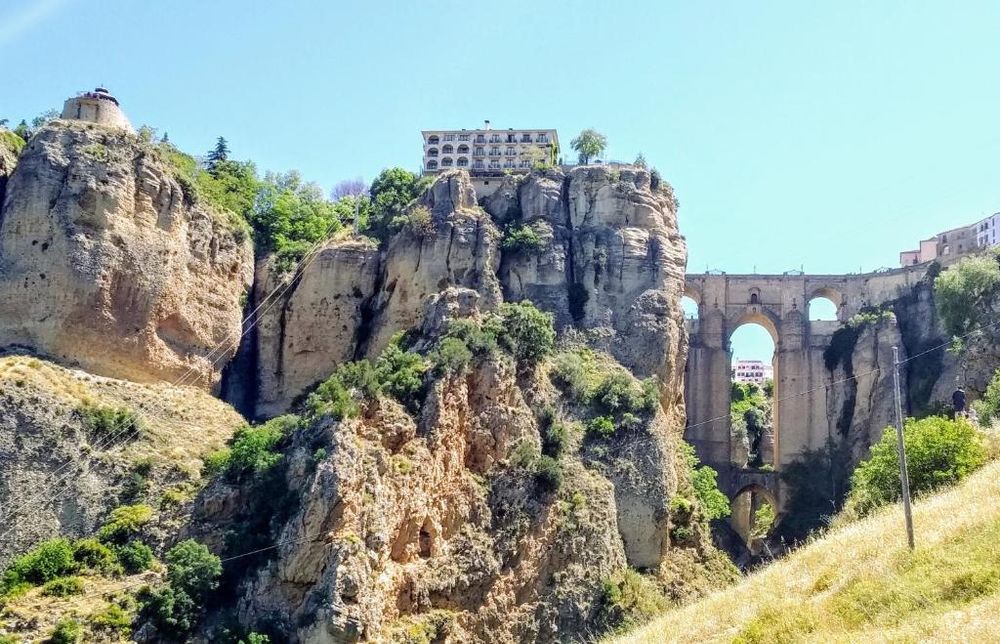 Spain
Spain
Parador de Ronda
4* hotel with spectacular views of the Ronda Gorge and the Pont Nuevo (New Bridge)Day 4: Seville
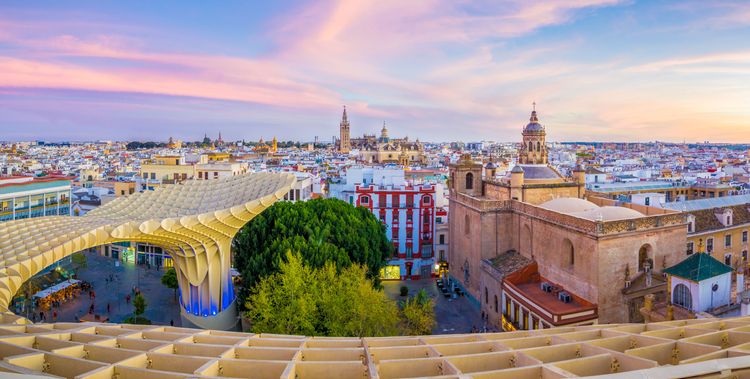
Vue aérienne de Séville
- © LucVi / ShutterstockIt takes around 1 hour 45 minutes to drive to the capital of Andalusia. How can you resist the charm of Seville? The pedestrianised centre lined with orange trees (there are 80,000 of them!) and neo-Mudejar-style facades is a delight. Of course, there are Seville's must-see treasures: the cathedral, dazzling with the mausoleum of Christopher Columbus. It is dominated by the Giralda, the former minaret of the Great Mosque converted into a bell tower, which rises to a height of 98 metres. The summit offers an admirable view of the city. A UNESCO World Heritage Site, the Alcazar Palace and its gardens are reminiscent of the Alhambra in Granada.
Seville is home to some lesser-known but equally fascinating places, such as the Flamenco Dance Museum, housed in a superb mansion built around its Andalusian patio. Lose yourself in the maze of narrow, picturesque streets in the Juderia, Santa Cruz and El Arenal districts, wandering through small squares and flower-filled patios, and don't hesitate to cross the Guadalquivir to lose yourself in the working-class Triana district, a former stronghold of sailors and gypsies. Last but not least, you can't miss the emblematic Plaza de España!
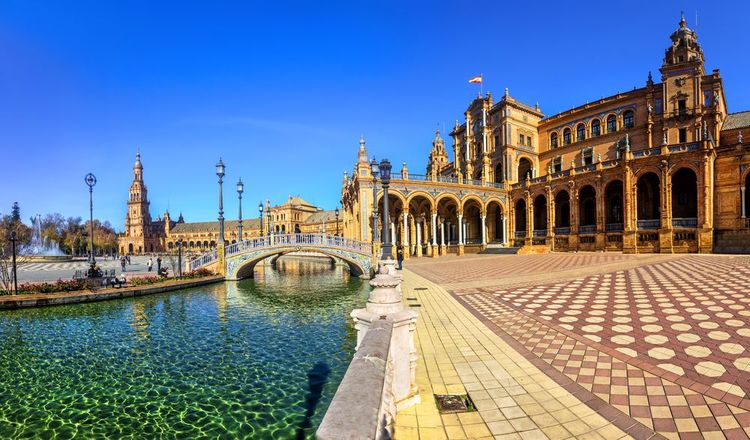
Place d'Espagne à Séville
- © May_Lana / ShutterstockThe Spanish Steps
Built for the Ibero-American Exhibition in 1929, the Plaza de España is a vast semicircle 200 metres in diameter bordered by an impressive brick and ceramic palace, one of the wonders of the city. Its blue tiles, known as azulejos, tell the story of 48 of Spain's 50 provinces, in alphabetical order. There are also four majestic bridges decorated with ceramic tiles, spanning an inland canal.
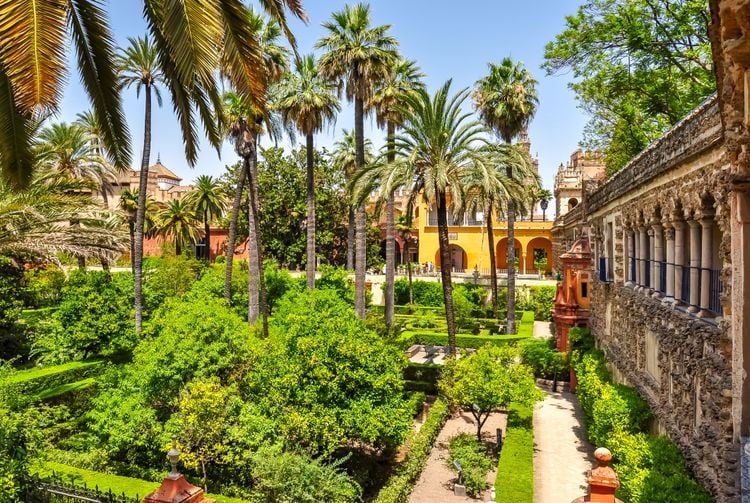
Jardins de l'Alcazar
- © Mistervlad / ShutterstockAlcazar Gardens
A UNESCO World Heritage Site, this Muslim citadel and its Arab-influenced gardens are a foretaste of the Alhambra in Granada. Fountains, fountains, pools, sculptures and flowering trees add extraordinary charm to this enchanting place.

Giralda
- © Aranami / ShutterstockThe Giralda
Dominated by a Moorish tower dating back to 1198, the Giralda (weathervane) is THE must-see monument in Seville and a UNESCO World Heritage Site. The top of the minaret of this former mosque is crowned by a weathervane, a huge bronze figure representing the victorious Faith and giving the tower its name. This former minaret of the Great Mosque (and twin of Marrakesh's Koutoubia) has been converted into a bell tower, reaching a height of 98 metres. For a long time, it was the tallest tower in the world!
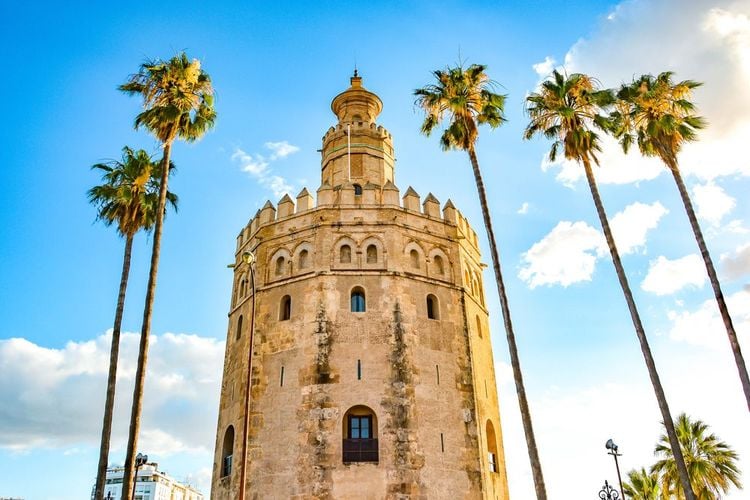
Torre de Oro, la tour de l’Or
- © The Escape of Malee / ShutterstockTorre de Oro
Nestling on the banks of the Guadalquivir near the San Telmo bridge, this imposing 13th-century medieval Almohad tower housed the gold brought back from the New World by the conquistadores from the 15th century onwards. But if it's called the Tower of Gold, it's not because it was used to store gold, as you might think, but because the building was originally covered in golden metal tiles!
👉 Where can you hear flamenco?
In the penas, amateur circles that regularly invite quality artists, generally better than the tourist shows offered in the tablaos. The best known are the El Arenal tablao and the Los Gallos tablao (Plaza de Santa Cruz, 11). La Carboneria in the Santa Cruz district is a must-see. It has a very festive atmosphere. In the first, intimate room, you can listen to jazz or the improvisation of anyone who wants to play. The second room is given over to flamenco, with singers, dancers and musicians performing from 10.45pm until late into the night. Finally, there's a large outdoor patio where you can enjoy the balmy nights.
For party-goers in search of a more authentic experience, wander into the Santa Cruz barrio and you'll end up at the Mariscal Bar-Copas for a drink in a Sevillian setting and atmosphere in the company of the locals. Open the door to the back room and you'll find regulars singing and dancing their very own flamenco!
Every two years, the Seville Flamenco Biennial is a world-renowned event held in September.
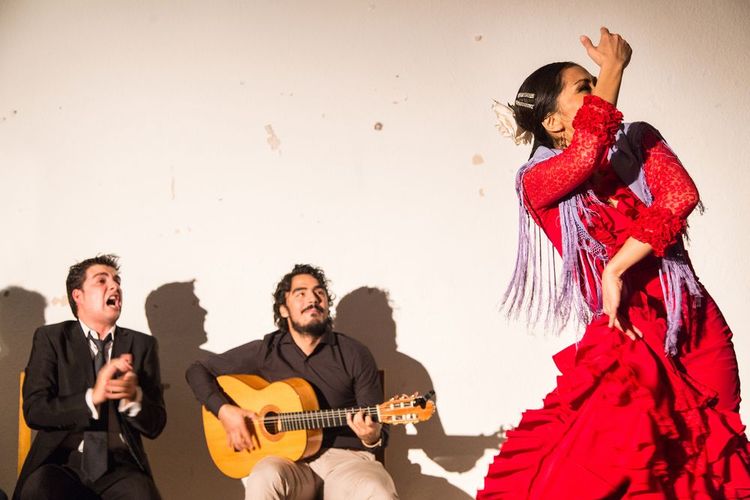
Danseuse de flamenco
- © Marcin Krzyzak / ShutterstockWhere to eat in Seville
The question is: what's for dinner? Tapas, of course! In Seville, as in the rest of Spain, tapas are a great gastronomic tradition. In fact, it's said that they were invented in Seville! At the counter of an authentic bar with walls covered in azulejos and hanging hams, on the terrace of a café, or at the table of a restaurant, you can enjoy small portions of the most varied dishes (cold meats, cheese, prawns, olives...), accompanied by a glass of Malaga, Jiora, sangria or cold cerveza (beer). Looking for a good place to enjoy delicious tapas? We recommend the bodeguita A. Romero, calle Antonia Diaz, right next to the Maestranza bullring. A typical, friendly atmosphere, and absolutely divine tapas!
Where to stay in Seville
⭐Las Casas de la Juderia
Las Casas de la Juderia is a unique concept, a veritable city within the city located in the old Jewish quarter in the centre of Santa Cruz. 32 patios, flower-filled gardens adorned with fountains, a swimming pool, rooms worthy of the Palace of Versailles, cobbled streets, top-flight gastronomy, a spa all in breathtaking mosaics, and even an underground gallery! That's what this unusual address has to offer, plus many more surprises! Come and discover this unclassifiable establishment, halfway between a Moroccan riad, an Andalusian village and a palace from the Arabian Nights! One of our favourites in Seville, not far from the cathedral and its Giralda, and a stone's throw from the Alcazar palace.
 Seville
Seville
Hotel Las Casas de la Judería
This 4-star hotel occupies 27 traditional Sevillian houses, linked by passageways and courtyards. Classically decorated, it boasts a rooftop swimming pool, spa and traditional Andalusian patios.Day 5: Donana Park, a touch of nature and adventure
Just an hour and a half's drive from Seville, La Donana is one of Europe's most beautiful nature parks. Listed as a Biosphere Reserve and World Heritage Site by UNESCO, Europe's largest wetland area can be explored by 4x4 between sand dunes, pine forests and marshes, and even in the waves on the beaches of the Atlantic Ocean!

Parc national de Donana, près de Mazagon
- © Iulius Agency / ShutterstockCreated in 1969, the Donana National Park covers 75,000 hectares. If you're lucky, you might spot a lynx, but in any case, you'll have the opportunity to observe pink flamingos, wild boar and deer frolicking among the marshes and dunes. At times, you'll think you're in the Sahara! Some of the dunes are up to 30 metres high, and several scenes from the legendary film Lawrence of Arabia were filmed here. In the blink of an eye, you'll move from the beaches of the Atlantic Ocean to the sand dunes, from the marshes to the pine forest, via the freshwater lagoon, with a few stops along the way for animal encounters. Grab your binoculars!
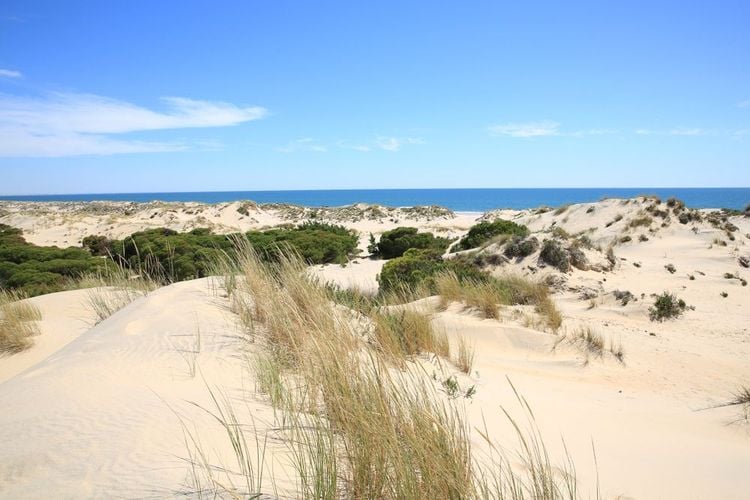
Dunes dans le parc de Donana
- © Traveller70 / ShutterstockAdvice from the editor
You are strongly advised to bring a good pair of binoculars if you hope to see endangered species such as the Spanish lynx and the Iberian eagle. Extremely protected, this park is car-free and can only be explored by 4x4 with a guide and driver. We advise you to start early in the morning, around 8am, as the tour lasts almost 4 hours! The khaki green all-terrain vehicles leave from the El Acebuche reception centre. The 35 km of unspoilt beaches stretch as far as the eye can see, right down to the mouth of the Guadalquivir! You can expect to pay between €80 and €250 for a day's guided tour in a 4x4 vehicle.
👉 Anecdote: several archaeologists believe that the mysterious city of Atlantis is buried beneath these marshes! It is thought to correspond to the mythical city of Tartessos, which really did exist!

